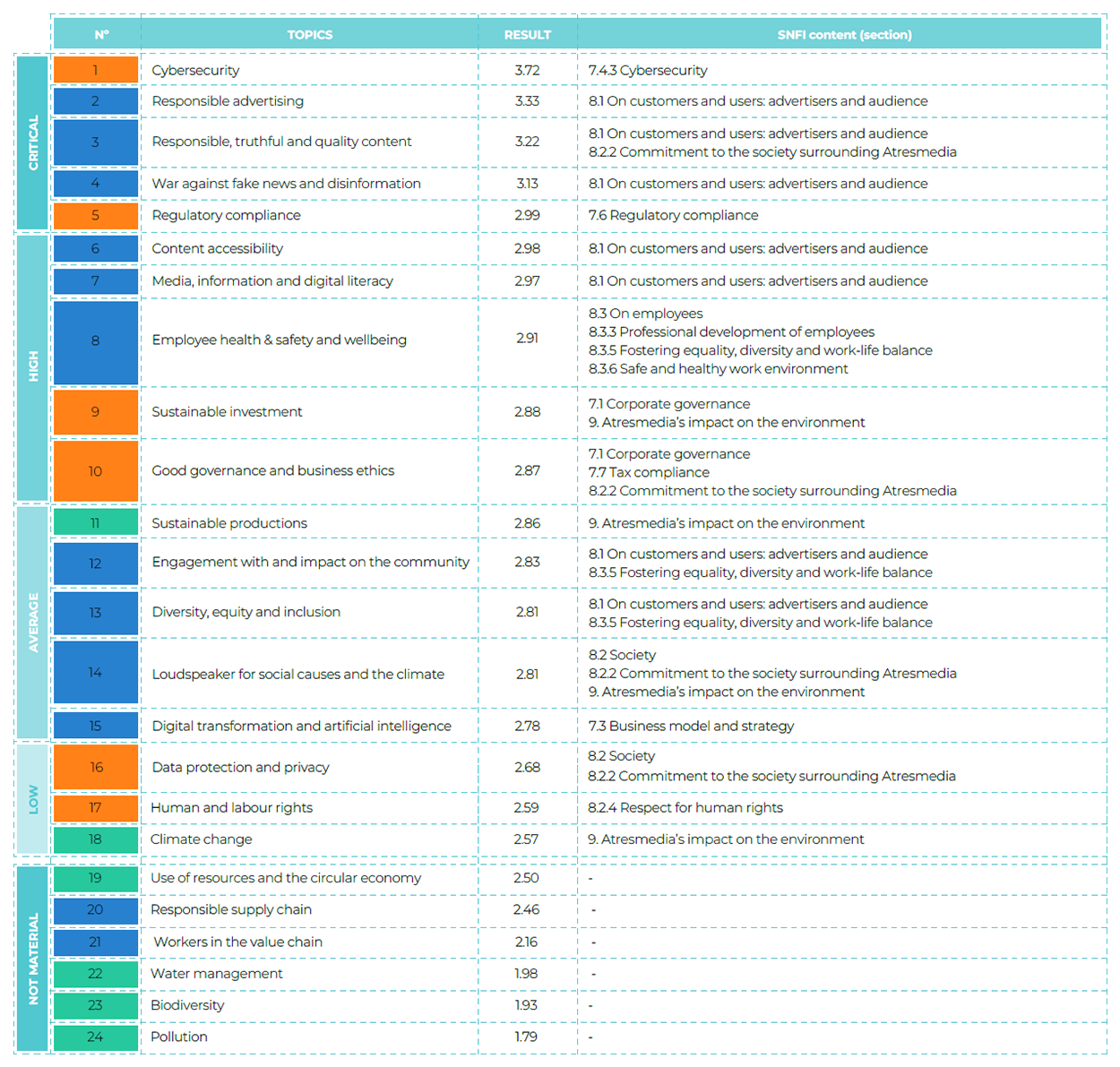Double Materiality Assessment
Double materiality assessment
The principle of double materiality unites two perspectives: the impact perspective, i.e. the impact that the Group’s operations have on the local community and environment, and the financial perspective, in the sense of how conditions unrelated to the Group can affect its financial performance
Atresmedia carried out an assessment to obtain a closer understanding of those issues with an environmental and/or social impact, and of the risks and opportunities it is now facing due to the environment in which it operates. Notably, these issues were analysed not only in relation to the Group’s own operations, but also along its value chain.
In order to carry out the dual materiality assessment, a methodology based on the following four key phases was developed:
- Comprehension phase: focused on comprehensively understanding the Group’s business and operations. This assessment allowed the Group to categorise its operations into two main blocks: first, content-related activities, which include the audiovisual, radio and advertising lines that make up the core business; and second, activities related to diversification, which largely comprise activities that are not dependent on content creation.
- Identification phase: the aim here was to identify issues related to the impact that Atresmedia generates on the environment and society along its value chain, as well as any aspects that may affect the Group’s performance arising from the material sector-related issues identified during the understanding phase. During this phase, Atresmedia also consults internal and external sources in the media & entertainment industry.
- Evaluation phase: here we defined a mechanism for evaluating relevant issues in order to determine their materiality. Atresmedia’s main stakeholders took part in this evaluation, including employees, shareholders and investors, suppliers, customers and society.
- Determination phase: to reliably define, based on internal thresholds, the material impacts, risks and opportunities (IROs) for the Group.
Key results of the double materiality assessment
During the double materiality assessment, each relevant IRO was analysed in order to gauge its degree of importance, both for Atresmedia and its stakeholders, and to link these issues with the themes and sub-themes of the ESRS (currently being prepared ahead of the entry into force of sustainability reporting under the CSRD in 2025)2.
After analysing the results of the assessment process, the following topics were identified as being non-material: resource use and circular economy; responsible supply chain; hourly employees; water management; biodiversity; and pollution. When comparing those topics flagged as material in 2023 with those found to be material under the previous assessment, the following topics were considered priority concerns in both processes: responsibility for both news and entertainment content, advertising (truthfulness, independence, transparency, diversity, child protection, reputation, etc.) and the fight against fake news and disinformation.
Aspects related to cybersecurity have increased in materiality, with cybersecurity now being the most important aspect. Regulatory compliance is another of topic that has significantly increased its degree of importance, not only due to its significance in terms of reputation but also because it is viewed as very important by investors and shareholders alike. Other topics to have increased in importance include sustainable investment, sustainable productions, acting as a mouthpiece for social and climate concerns, and community relationship and impact.
Meanwhile, certain other material topics were identified in 2023 that had not been identified in previous assessments, such as aspects related to human and labour rights3; diversity, equity and inclusion; accessible content; media, information and digital literacy; and climate change.
Double materiality matrix
The thematic grouping of IROs to form material topics can be found in the double materiality matrix, which features two main axes: the X-axis, representing financial materiality, and the Y-axis, representing impact materiality. This matrix shows all the topics identified and assessed, both material and non-material, thus reflecting one of the Group’s core values: transparency. The topics have also been classified according to their environmental, social and governance focus.
Once identified, the material topics were sorted into four categories according to their degree of importance: critical, high, medium and low. Critical topics were cybersecurity; responsible advertising; responsible, truthful and quality content; the fight against fake news and disinformation; and regulatory compliance. The materiality threshold for both impacts, and risks and opportunities, was defined based on the average between the topic with the highest value and the topic with the lowest value for both axes.


